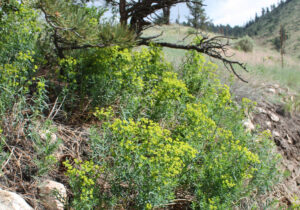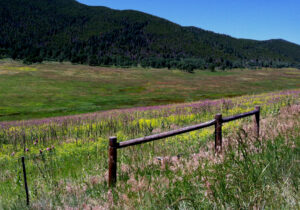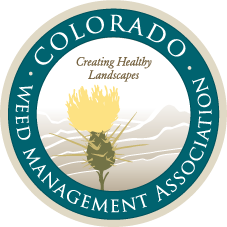Leafy spurge
Euphorbia escula
Leafy spurge is a perennial member of the spurge family. This List B noxious weed reproduces by seed and spreading roots. Seeds are expelled up to 15 feet from ripened seed pods and have a sticky gel-like substance on their surface that allows seeds to stick onto wildlife, pets, humans, and equipment. Roots grow horizontally to 15 feet and vertically to 30 feet. Plants can grow from root fragments as small as 1/8-1/4 inch long. Roots have growth buds along their length that give rise to new plants.
Leafy spurge flowers from May through July. The flower parts are inconspicuous and are found in the middle of modified bracts that are bright yellowish green. These form clusters at the ends of stems.
Leaves are narrow, about 1-4 inches long, with smooth surfaces and edges.
Plants grow to about 3 feet tall. Stems are thin. Plants have a milky latex sap that can be toxic. It can cause blistering on the lips of livestock. Plants may appear reddish in the fall.
In some areas of Colorado Leafy spurge populations have declined significantly, in part due to biological control beetles. Visit CDA’s Insectary website for more info.
Leafy spurge is a problem in rangeland, pastures, parklands and riparian corridors.
Control includes good land management, biological control, and chemical. Mowing or grazing with goats combined with other methods has shown results in some areas.
What You Can Do
Choose weed-free hay when feeding hay to livestock
Survey your property in early spring to identify patches of leafy spurge so you can control it before it seeds
Do not walk or drive through patches of leafy spurge
Resources




